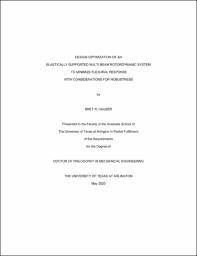
ATTENTION: The works hosted here are being migrated to a new repository that will consolidate resources, improve discoverability, and better show UTA's research impact on the global community. We will update authors as the migration progresses. Please see MavMatrix for more information.
Show simple item record
| dc.contributor.advisor | Wang, Bo Ping | |
| dc.creator | Hauser, Bret R | |
| dc.date.accessioned | 2020-06-15T13:32:06Z | |
| dc.date.available | 2020-06-15T13:32:06Z | |
| dc.date.created | 2020-05 | |
| dc.date.issued | 2020-04-08 | |
| dc.date.submitted | May 2020 | |
| dc.identifier.uri | http://hdl.handle.net/10106/29110 | |
| dc.description.abstract | Modern rotating machines are often required to operate with a small physical footprint and/or overall weight; necessitating that they utilize wide-ranging shaft speed to accomplish needed power levels. It is not uncommon that these designs also be required to support operation through a speed range encompassing multiple Critical Speeds while also limiting flexural vibrations to acceptable levels. Design optimization of this class of problem can be particularly difficult in that responses can be highly multi-modal and, when coupled with Finite Element (FE) solvers meet the conditions of a High Dimensional, Computationally Expensive Black Box (HEB) system. Because of this, some conventional optimization methodologies have limited effectiveness or efficiency due to challenge with ‘crossing’ local maxima in search of the optimal solution. Additionally, conventional optimization methods that might be employed for HEB functions do not provide information regarding the Robustness of the identified solution.
An efficient 2-step method is developed using a modification of the conventional first-order method of Steepest Descent followed by a more efficient Sequential Quadratic Programming method to identify optimal solutions. A deterministic penalty method as well as programmatic considerations make the modified first-order method applicable to constrained searches. A Rotordynamic FE code is developed as part of this work leveraging both Eigenanalysis and Component solutions of the EOM as efficient methods for identifying Critical Speed frequencies and flexural responses. With the addition of considerations for Robustness during the optimization process, an efficient and practical tool is developed to guide the user regarding solutions to the HEB Rotordynamic design problem. | |
| dc.format.mimetype | application/pdf | |
| dc.language.iso | en_US | |
| dc.subject | Rotordynamic | |
| dc.subject | Optimization | |
| dc.subject | Fea | |
| dc.subject | Robustness | |
| dc.title | DESIGN OPTIMIZATION OF AN ELASTICALLY SUPPORTED MULTI-BEAM ROTORDYNAMIC SYSTEM TO MINIMIZE FLEXURAL RESPONSE WITH CONSIDERATIONS FOR ROBUSTNESS | |
| dc.type | Thesis | |
| dc.degree.department | Mechanical and Aerospace Engineering | |
| dc.degree.name | Doctor of Philosophy in Mechanical Engineering | |
| dc.date.updated | 2020-06-15T13:32:06Z | |
| thesis.degree.department | Mechanical and Aerospace Engineering | |
| thesis.degree.grantor | The University of Texas at Arlington | |
| thesis.degree.level | Doctoral | |
| thesis.degree.name | Doctor of Philosophy in Mechanical Engineering | |
| dc.type.material | text | |
| dc.creator.orcid | 0000-0003-3809-4105 | |
Files in this item
- Name:
- HAUSER-DISSERTATION-2020.pdf
- Size:
- 15.72Mb
- Format:
- PDF
This item appears in the following Collection(s)
Show simple item record


